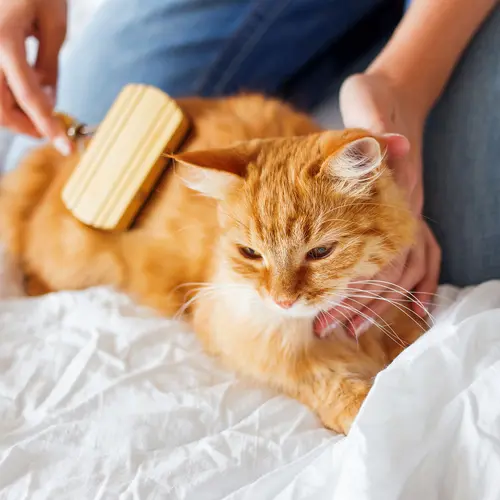Most dog and cat owners consider their canine and feline friends full-fledged members of the family. That means when birthdays, major holidays, or other celebrations roll around, dogs and cats get gifts too - and lots of them.
Whether you’re shopping for your own pet or for a friend’s, here is what you need to know about pet gift safety regulations and possible hazards.
Pet Product Safety
The U.S. Consumer Product Safety Commission focuses solely on products made for human use. Ed Rod, vice president of government affairs and general counsel for the American Pet Products Association, tells WebMD that pet product safety is instead market driven, where manufacturers and retailers focus on these issues:
- Choking hazards and small parts
- Strangulation hazards
- Toxicity levels
Also, major retailers require that pet product makers use quality-control testing laboratories to certify product safety before allowing items on store shelves.
“Fortunately, with pet toys and pet accessories,” Rod says, “there is not a big history of adverse events.”
Buyer Be Smart
Individual differences in pet play styles and motivations require pet owners to examine pet products for safety issues and supervise play.
“No pet toy is indestructible. Some pets are much more destructive. In fact, the destruction is much of the fun for most dogs and some cats. It’s a little bit of buyer beware,” says ASPCA’s Katherine Miller, PhD, a certified applied animal behaviorist.
Miller advises families to:
- Assume any pet product will be chewed up or torn apart, eventually
- Check pet gifts often for wear
- Remove any damaged items
Potential hazards include:
- Sharp pieces or edges, such as torn plastic toys, internal parts, squeakers, splintered bones
- Long strings, cords, ribbons, or unraveled fabrics
- Small parts, stuffing, or other items that pets might swallow
Don’t just look at the product exterior. Figure out what’s inside that could become a hazard if exposed. “Imagine the pet pulls it apart,” Miller says, “what’s inside might be what’s most interesting.”
Dog Gift Watch List
In the emergency and critical care unit at Tufts University Cummings School of Veterinary Medicine in Grafton, Mass., veterinarians worry most about things dogs swallow that they shouldn’t.
“I think dogs, relatively early in their lives, declare themselves as eaters of stuff or not eaters of stuff,” says Tuft’s Elizabeth Rozanski, DVM, a board-certified specialist in emergency/critical care and internal medicine.
Rozanski once treated a Doberman Pinscher famous for eating the family’s socks. Someone gave the dog a child’s sock puppet. He ate the whole thing and required surgery.
“It was something that for most dogs wouldn’t have been a problem,” Rozanski says, “but our big rule of thumb is that if the dog is specifically silly about something like that, then watch out for those kinds of toys. Some dogs will eat and swallow anything, so I don’t think I have anything that I sit here and think it’s specifically an unsafe toy as much as unsafe for a specific dog.”
Keep an eye on toy or pet product size. Often, Rozanski says, dogs get into trouble with items too small for their use, even if just by a little bit. For example, the ER sometimes sees dogs that have gotten marrow bones stuck in their mouths. “That’s not life-threatening,” Rozanski says, “but if the bone is just the right size, it gets stuck behind their canine teeth.”
Cat Gift Watch List
Dogs can have trouble if they eat linear or stringy objects, but cats are famous for it. These long items “have a higher potential to do damage," Rozanski says.
Miller agrees and cautions feline gift-givers to limit strings, ribbons, or nesting material used in wrappings or gift baskets - or cat products themselves.
Cats enjoy toys with dangly parts, but Miller says, “It should be an interactive-type game, not a self-play type of game.”
Kids Toys vs. Pet Toys
People sometimes offer dogs and cats children’s toys. On the surface, it might seem safe, but the two kinds of toys serve different purposes.
“Kids’ toys are often not suitable for pets because pets put toys under different stresses and actions than kids do,” Miller says. “So even though kids’ toys are tested for safety standards, they are meant for child-sized bodies and child strength and physical capabilities, not for predators. Dogs and cats are strong. They have sharp teeth. They can be persistent.”
Food Gifts for Pets
Barring any food allergies or intolerances, food items like pet treats make good gifts. If homemade treats are more your style, review pet poison resources, like those from ASPCA's Animal Poison Control Center, to ensure you skip common ingredients dangerous to pets.
Miller also suggests food-delivery toys for dogs and cats. These toys, which require work to get food out, provide much-needed mental stimulation to pets.
With each refill, the toy garners renewed interest. They also keep pets busy and away from other possible hazards. Miller says, “The toys smell like food, and it’s easier for a young pet, like a puppy, to learn it’s OK to chew on items that smell like food and not chew on items that don’t smell like food.”

